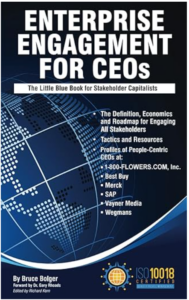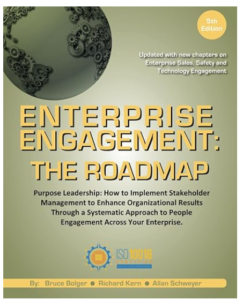Enterprise engagement: The practical foundation and framework for the successful application of the golden rule to management–enhancing returns for investors only by creating value for customers, employees, distribution and supply chain partners, communities, and the environment.
For decades, it was easy to ignore the issue of engaging stakeholders in the purpose of the enterprise because the return-on-investment was hard to define and almost impossible to measure. But for a growing number of organizations, the question isn’t if engagement matters, but how to make it happen. Now that the investment world is discovering the potential for enhanced performance by harmonizing the interests of all stakeholders in the organization’s purpose, the field of stakeholder management provides a roadmap for enhancing shareholder returns by creating value for society – customers, employees, suppliers, communities, and the environment. The field is also being driven by an increasing recognition that an ROI-based approach to Diversity, Equity, and Inclusion (DEI)–not virtue signaling or racial quotas–has become a business opportunity by broadening an organization’s marketplace for talent, customers, and supply chain, distribution, and community partners.
the enterprise because the return-on-investment was hard to define and almost impossible to measure. But for a growing number of organizations, the question isn’t if engagement matters, but how to make it happen. Now that the investment world is discovering the potential for enhanced performance by harmonizing the interests of all stakeholders in the organization’s purpose, the field of stakeholder management provides a roadmap for enhancing shareholder returns by creating value for society – customers, employees, suppliers, communities, and the environment. The field is also being driven by an increasing recognition that an ROI-based approach to Diversity, Equity, and Inclusion (DEI)–not virtue signaling or racial quotas–has become a business opportunity by broadening an organization’s marketplace for talent, customers, and supply chain, distribution, and community partners.
And now, the European Union has effectively mandated its principles in its 2022 Corporate Sustainability Reporting directive requiring organizations to provide detailed information on how their treat their own employees; those of their supply and distribution partners; as well as their distribution partners and end-user customers, and the employees in which they live. These new rules will not only affect millions of European countries but hundreds of thousands if not more organizations that do business with them.
The Stakeholder Capitalism movement and the Enterprise Engagement Alliance are strictly non-partisan and secular. Opposition to it comes from both the left and the right, while its principles are favored by the vast majority of Americans.
For a Youtube version of this overview presented in an interview with Bruce Bolger, founder of the Enterprise Engagement Alliance, click here. For a primer on Stakeholder Capitalism, with its formal definition, click here.

Disengagement costs American industry hundreds of billions of dollars per year in lost productivity and reduced sales. At the same time, extensive research proves that organizations with proactively involved customers, distribution partners, employees and suppliers consistently outperform their competitors in earnings and growth. Until recently, only a few major companies have had engagement strategies or anyone specifically in charge of engagement.
No one can estimate the cost of failing to diversity an organization’s marketplace for talent, customers, supply chain and distribution partners in terms of lost opportunities.
The neglect of human capital is beginning to end. Over the past several years, organizations have begun to recognize that people truly are an organization’s most critical asset and that the contribution of human capital can be managed and measured. In fact, this new recognition has led to the emergence of Stakeholder Capitalism, a new approach to achieving organizational goals by addressing the needs of all stakeholders, but just shareholders but customers, employees, distribution partners, suppliers, and communities. Hundreds of leading companies have put top management in charge of customer and employee engagement (also known as “experience”) strategies designed to find ways to increase customer loyalty and employee quality and productivity. More and more of these executives have the word “engagement” in their titles; for others it’s internal branding or customer experience or employee engagement. Organizations are spending more and more on outside experts, some now known as engagement agencies or consultants, who understand and/or can implement all of the elements that go into engaging any audience. What still is lacking is a strategic and systematic approached linked to organizational goals.
While Stakeholder Capitalism provides the principles, Enterprise Engagement is about the actual implementation process: achieving goals by fostering the proactive involvement of each and every customer, distribution partner, employee, vendor, or community member whose actions can affect results. The new focus on people puts a spotlight on the opportunity to optimize performance by having the broadest possible marketplace for talent, customers, and business partners, not only for the purposes of social equity but for competitive advantage.
Enterprise Engagement reflects the shift in emphasis from mass marketing to one-to-one-relationship building. Driving the change is the growing ability of organizations to measure the impact of engagement through customer relationship management (CRM) and social networking, and the increasing recognition by top management that engagement can provide a competitive advantage. The Internet, combined with the ability for almost any organization to manufacture offshore, has reduced the traditional cost and service differentials between organizations. Today, even a little company can find a niche amidst the giants.
Enterprise Engagement redefines the concept of a brand. Traditionally, brands were designed to communicate carefully defined values and promises to customers. Today, brands are designed to build relationships with everyone—from customers and distribution partners, to employees, vendors, and even communities—so that everyone who touches the organization has a clear vision of what the brand stands for and what they should expect from it.
A More Humane Capitalism
The world is clamoring for a more humane form of capitalism that values people – employees, customers, vendors, partners and communities. In a word: Stakeholder Capitalism. For organizations dedicated to engagement, which include the likes of Whole Foods, the Container Store, Southwest Airlines, N.Y., regional grocer Stew Leonard’s and many others, it’s more of a journey than a science because business books and media provide so little guidance on how to proceed, and so few traditional agencies and consultants take a holistic approach to helping organizations do whatever’s necessary to direct everyone’s energies to those tasks that yield organizational success. Stakeholder Capitalism looks at social and racial inequities as problems that can be profitable to solve.
The Leadership/Engagement Connection
 It’s easy to confuse leadership with engagement. Leadership, of course, is essential to engagement. It describes the personal skills required of people who manage at any level, including the ability to create a culture based on providing clear direction, support, learning opportunities, enthusiasm, a sense of mission, constructive feedback, ability to recruit, etc. Yet leadership is only the first element of Enterprise Engagement.
It’s easy to confuse leadership with engagement. Leadership, of course, is essential to engagement. It describes the personal skills required of people who manage at any level, including the ability to create a culture based on providing clear direction, support, learning opportunities, enthusiasm, a sense of mission, constructive feedback, ability to recruit, etc. Yet leadership is only the first element of Enterprise Engagement.
The larger the organization – the more consumers, distribution partners, employees, volunteers, vendors and others are involved – the more complex it becomes to engage. The process requires more than leadership and a general goal. It requires informing people of the mission and how they can contribute or benefit. It requires providing people with the capability or skills to contribute and foster an emotional connection that makes them want to become involved, share and collaborate. It’s about translating leadership into results through an appropriate framework of tools and tactics based on the specific organization, culture and marketplace. It requires not only making promises, but also delivering on them every step of the way.
From a tactical standpoint, Enterprise Engagement is to the 21st century what advertising was to the 20th. It’s a new field based on a new set of skills that integrate an understanding of leadership; an organization’s different audiences; the tactics that can affect engagement (communication, learning, collaboration, rewards and recognition, etc.); and measuring the impact of these activities on the bottom line. It addresses DEI as a business opportunity baked into the overall human capital management plan.
Enterprise Engagement involves many issues foreign to the typical marketing executive. Marketing focuses on selling; engagement requires a willingness to stop selling and instead focus on helping and enabling. This means marketing that informs instead of hypes. Marketers routinely distort; engagement requires total sincerity, a commitment to fulfilling marketing promises. Few people believe advertising and marketing messages, and yet the field continues to thrive; engagement cannot work unless it’s 100% sincere, because otherwise people see through it.
Enterprise Engagement requires an understanding not just of customers, but of the link between all organizational audiences, external and internal. Engagement requires an understanding of the new definition of the brand, as well as the tactics and tools necessary for learning, collaboration, rewards and recognition, all alien to traditional advertising experts. Enterprise Engagement requires the ability to align strategies across organizational and tactical silos so all functions and constituencies mesh with an organization’s people and goals.
The Organizational Challenge
The emergence of Enterprise Engagement is evidenced by the emergence of new titles that incorporate the concept of engagement, including people in charge of customer engagement or experience, as well as employee engagement. The concept is still so new that organizations aren’t quite sure of the skill sets required and are putting people with diverse backgrounds into such positions.
Implementing engagement at any level is a journey, not only because there are no textbooks (until now), but because traditional business consultants don’t provide all the answers. The typical consulting practice is broken up into different silos that reflect those of their clients – benefits, compensation, assessment, organizational design, organizational development, talent management, process management, recruitment, etc. But by focusing on the needs of customers and all of the people required to serve customers, Enterprise Engagement challenges organizations to break the old management style that focuses more on processes than people.
An Implementation Framework
The outline below provides a basic framework for building an Enterprise Engagement strategy into a Stakeholder Capitalist enterprise and monitoring its progress. Based on dozens of research studies, here are the fundamental elements of engagement that this framework is designed to address:
- Clear sense of mission – What the organization stands for
- Clear goals – Where do we want this relationship to go?
- Emotional bonding – A sense of community and camaraderie
- Capability – Do people have the resources and knowledge to do what is asked of them?
- Fun – A sense of humor and good-naturedness
- Support – A sense of being valued and that someone human is overseeing the process
- Task value – A sense that what I’m doing has purpose
- Feedback – Meaningful suggestions on how to improve.
Rather than placing siloes between audience management and the tactics used to engage customers, employees, supply chain and distribution partners, and communities, stakeholder engagement aligns toward a common purpose the promises made to an organization’s various stakeholders and the many tactics used to engage them: culture, customer and talent recruitment, assessment and feedback, communications, learning, DEI (diversity, equity, inclusion), innovation and collaboration, rewards and recognition, analytics, etc. For the purposes of human capital management and reporting, these can be organized under the following areas outlined in ISO 30414 Human Capital and ISO 10018 People Engagement standards:
- Leadership Transformation
- Diversity, Equity, Inclusion
- Occupational Health and Safety
- Organizational Culture Alignment
- Productivity and Quality
- Skills, Capabilities, Job Design
- Recruitment, Mobility, Turnover
- Customer Engagement
- Supply Chain and Channel Partners
- Community Engagement
- Metrics and reporting
Addendum
- Costs
- Compliance
- Workforce Availability
- Employee Bench Strength aligning the interests of all stakeholders as well as the processes used to engage them.
All of these subjects and more are captured in the new EU Corporate Sustainability Reporting directive.

